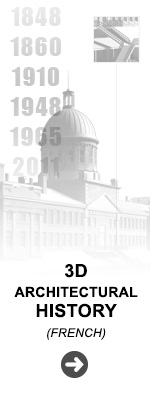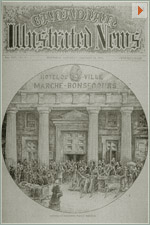FROM ONE ERA TO THE NEXT
| A Site that has been Marked by History |  |
  |
||
| A Monument that Proudly Bears the Colours of a Nation | ||||
| The Bonsecours Market, at the Heart of Canadian History | ||||
| A Catalyst for Montrealers' Civic and Cultural Activities | ||||
| A Site that has been Marked by History |
The site where the Bonsecours Market would eventually be built was at the centre of the social and cultural activities of the colony, both under the French regime, and later on, after the Conquest. Numerous prominent personalities have made it their home beginning with Charles Le Moyne de Longueuil. In her private hotel, Madame Bégon, a renowned woman of letters, held court; her counsel was widely sought by all the VIP's that would come through her front door day in and day out. François Bigot, the last Intendent of New France lived there from 1749 until his return to France, in 1760. John Johnson, an ardent loyalist, Superintendent General and Inspector General of the Six-Nations Indians, as well as the Indians in the Province of Quebec, amongst other positions, bought the residence in 1796 and resold it to John Molson, in 1815. This pioneer of steam navigation along the Saint Lawrence River, who longed to have access to the river even built a pier there. Molson expanded and refurbished the Mansion House Hotel. The site quickly became the Beaver Club's meeting place of choice and was the recipient of 7,000 books from a "group of civic-minded gentlemen". After a fire, Molson built the New Mansion House, which was subsequently called the British American Hotel, which in turn was destroyed by fire in 1833. The site also played host to the Théâtre Royal where Charles Dickens and his band of amateur actors staged a production. This theatre carried on its activities for about twenty years before being demolished. Its ruins remain buried beneath the foundation of today's Bonsecours Market. John Molson's son sold back to the City the major portion of the land that would be used for the establishment of the new Bonsecours Market, whose construction began in 1844. The Public Market was inaugurated in January 1847. The refurbishment of the market's interior, under the direction of architect George Browne, continued up until 1852. |
|||
| A Monument that Proudly Bears the Colours of a Nation |
After a call for tenders, the Municipal Council chose the design submitted by William Footner. In his presentation, the latter insisted upon the location of the new building and upon the symbolism of its shapes. He wrote that in order that "the plans provide the means to build an edifice that was appropriate for the circumstances, it would have to bear the colours of the nation". Indeed, he asserted the importance of establishing a monument that "would confirm the fine taste and the magnanimity of the citizens of Montreal". The majesty of the building must... "impress upon the traveller's mind an overwhelming image of the beauty and importance of the flourishing City of Montreal". In this manner, he wrote in his presentation, "the shores of the Saint Lawrence shall be graced with a building worthy of this river that ceaselessly shares its wealth with us". "Architecture in Canada, he said, must only aim towards that which possesses a dignified grandeur, a modesty that is attractive, a balance in its proportions, and finally a harmony in all its parts, that is a prerequisite for all great works of art and literature". Footner's contribution is moreover highlighted in an article published by the magazine "Award" that recognizes the Bonsecours Market as one of the ten major achievements in the History of Canadian Architecture. |
 The Marché Bonsecours "meat market" during the 19th Century Photo : Ville de Montréal  The Marché Bonsecours and the Notre-Dame du Bonsecours Chapel, at the very heart of Montreal's History Print : Ville de Montréal |
||
| The Bonsecours Market, at the Heart of Canadian History |
The increasing industrialization of Montreal provoked a sharp increase in her population and the City Fathers wished to endow the city with sizeable halls which could accommodate and entertain large crowds. Meanwhile, various proposals to the effect that Montreal be made the home to Canada's Parliament caused the civic administration to ask the architects to design areas in the top floors to accommodate gatherings of people for the purposes of public readings, theatre and music, as well as to make room for offices. These projections were borne out, although only for a short period of time. First of all, the colonial government had already rented the Sainte-Anne Market, which had been recently renovated, to temporarily house the Parliament of the United Canada. Subsequently, when Tory rioters burned down the Sainte-Anne Market Parliament Building on April 25, 1849, the Bonsecours Market was thus admirably positioned to have its turn to accommodate the Parliament. Protected by troops with fixed bayonets, the Members of Parliament sat at the Bonsecours Market from April 26 to May 7,1849. The parliamentary session continued until May 30 in a building in Place Dalhousie belonging to Moses Judas Hayes. |
 A long tradition of banquets at the Marché Bonsecours Photo: Archives Nationales du Québec  Political Activity at the Marché Bonsecours Photo : Ville de Montréal |
||
| Bonsecours Market, a Catalyst for Montrealers' Civic and Cultural Activities |
The Bonsecours Market also housed Montreal City Hall for more than twenty-five years. In 1852, the Municipal Council sat for the first time in a building that belonged to the municipality. It only left in 1878 to move into a brand new City Hall on the site of the present-day City Hall, located on Notre-Dame Street. It is interesting to note that the City Hall was also occasionally used as an exhibition hall and to host various festivities. In order to meet the increasing demand, the Council mandated the architect George Browne to design a concert hall in the East Wing of the building, the "City Concert Hall", as well as an adjoining banquet hall. The concert hall, which had an area of over 900 square metres, was designed in a Victorian style and did not have any rivals for about ten years. Mayor Wilson described it as being able to accommodate 3 000 people. The Bonsecours Market was the principal public market in Montreal for more than one hundred years, and as such constituted a genuine reflection of the social and economic evolution of the country, as the use of its halls so amply testify. The Canadian Institute was the very first lessee, when they organized a huge Saint-Jean-Baptiste celebration on June 24,1846, even before all the work to complete the building had been finished. It rapidly became the preferred showcase for Canadian industrial production. In 1850, a first Provincial Fair was held there, which was also the very first public exposition of manufactured and farm products in Canada. This exhibition was where participants were chosen to attend the World's Fair in London. After the inauguration of the City Hall, on January 13,1852, the municipal firefighting companies inaugurated the new hall by organizing a Benefit for the Firefighters Benevolent Association for Widows and Orphans. It was also at the Bonsecours Market that the renowned Train Festival was held in 1856. The jubilee of His Eminence Bourget was celebrated there - as was a banquet in honour of the troops who had served in the Crimean War. Often refurbished, a police gymnasium was set up within its walls and for long stretches of time, its large enclosed areas were used as an armoury, as well as a place to train the militia and the army. Exhibitions, conferences and sound and light shows follow on each other's heels within the Market. The farmers market evolved considerably over the years in tune with the technological advances of the times, the evolution of the public's likes and dislikes and manifold demographic transformations. When it was closed in 1963, it was still considered to be the "central" market, the point of contact between Montreal and its countryside. The construction of massive grain silos at the river's edge produced a certain loss of prestige for a short time, but their demolition in the 1980s gave back a precious point of reference to the citizens of Montreal. Now completely restored and renovated to meet the needs of the future, the Bonsecours Market turns over a new page in its unfolding story. |
|||


